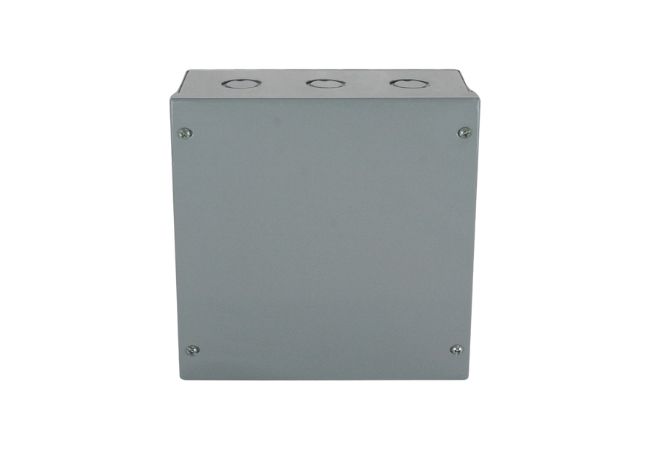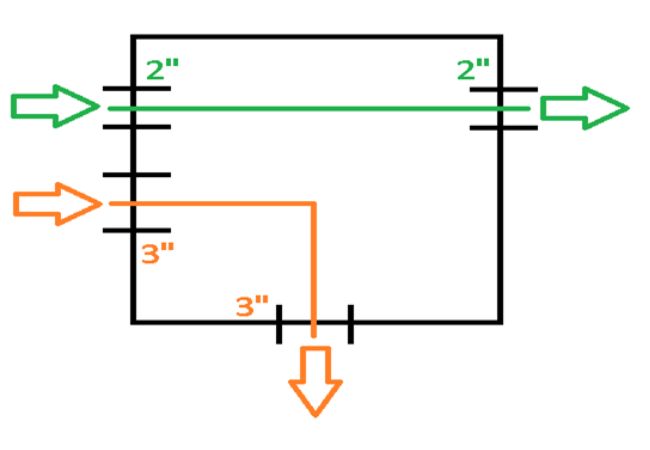
There are difference electrical boxes types that are crucial for encasing wire connections in any electrical installation system. This article compares junction box vs pull box, including types, sizing and spacing between these electrical boxes.
Definition
Junction Box
Junction boxes are plastic or metal electrical boxes utilized as housing for cable connections. They allow for easy wire access because you only need to unfasten the covering to perform modifications, additions, or repairs to a conduit.
Junction box installation also helps in protecting the wiring from environmental elements and unwanted tampering.

More Resources:
Pull Box
A pull box describes an electrical box that gives access to pull electrical cables through non-metallic or metallic raceways and conduit. They give you a means to pull conductors across an extended distance without putting too much tension on the cable or insulation.
You should install a pull box at strategic locations in electrical conduit systems to allow connection of long wiring runs in shorter intervals.
Their use is compulsory in electrical raceways where the number of loops between outlets surpasses maximum number allowed by the National Electric Code.

More Resources:
Types
There are various types of both of the two electrical boxes, which include:
Types of Junction Box
Electrical junction boxes come in varying sizes and shapes based on the purpose you design them for. Generally, the following are the primary junction box types:
Standard Junction Boxes
These are usual electrical junction boxes used in ordinary electrical wiring connections in homes. They have small to medium sizes and are made from simple plastic or metal materials.
Installing standard junction box is simple and it does not have many wires within. Their installation process is uncomplicated because of the low amount of energy required by most residential house.
Round Pan Junction Boxes
These are round junction boxes that take the shape of a pan, with most having a ¾ depth. They are the best types of electrical junction boxes for forming junctions within the walls and/or ceiling for light electrical parts. Most come as metal electrical boxes and are exceptionally efficient in separating wires in all sections of the electrical installation.
Octagon Junction Box

As suggested by the name, these are junction boxes having an octagon shape. They take up less space and mostly find use in ceiling electrical wiring connections. Moreover, they are highly flexible and can house beyond what their capacity permits.
Gang Junction Box
There are different types of gang junction boxes, from 4-gang, 3-gang, and 2-gang versions. They all have similar structure and are fabricated using metal.
Gang junction boxes are ideal as indoor electrical boxes, and you can employ 2-gang versions all through to 4-gang boxes.
Outdoor Junction Boxes
As the name hints, these are types of electrical boxes used in outdoor wiring connections. Typically, outdoor junction boxes fabrication use the toughest materials, mostly metal. When using these electrical boxes, ensure that they comply with all the NEC junction box standards.
Types of Pull Box
There are different types of pull boxes based on how the pulled cable enters and exits the electrical box.
- Straight Pull Box is that where you attach the conduit housing wires to opposing side of the electrical box. This allows a linear pull of wires via the conduit. For easier pulling, you may install it at intervals across a lengthy straight wire pull.
- Angle Pull Box is that where wires go in at a side perpendicular to the side via which they leave the box.
- U-Pull Box is that where the wires get into and leave the electrical box via the same side.

Junction Box Sizing
You do not need to perform any calculations when sizing a junction box because it is standardized. Rather, look through the chat in NEC 314.16 to establish the minimum and maximum volume of your electrical junction box. The chat applies if the size of the conductors within the junction box range from 18 AWG all through to 6 AWG.

Pull Box Sizing
Sizing of pull box depends on the number and size of conductors, in addition to diameter and number of raceways.
For 4 AWG conductors and above, you should size the pull box in compliance with NEC 314.28. We will give a summary of the pull box sizing standards for common pull types, together with a calculation illustration.
Straight Pulls
Determining pull box depth for straight pull depends on space needed for bushings and locknuts, and largest conduit size. Accordingly, you must ensure that the pull box length is not less than 8 times the largest conduit diameter.
- Assume an electrical pull box with 4 conduit runs, and has the largest diameter measuring 5”
- Minimum box length = 8 x 5” = 40”
Angle Pulls and U-Pulls
For angle and/or U-pulls, you should size the pull boxes according to NEC 314.28(A)(2).
Angle Pulls
Make sure that the distance between every raceway entry into the pull box and its opposite wall is the sum total of:
- 6 times the trade measurement of the biggest raceway within a row.
- The total of all additional raceway entries diameters in the row.
For instance, consider an electrical pull box with a 90 degrees having three raceways with 3”, 3” and 5” diameters. You should calculate the pull box size as follows:
- 6 multiplied by the biggest raceway diameter = 6 x 5” = 30”
- Sum of all additional raceway diameters = 3” + 3” = 6”
- Total = 30” + 6” = 36”
Furthermore, the linear distance between the points of entry and exit of every circuitry must be 6 times the corresponding conduit diameter. Therefore, the needed separations in the example illustrated above are:
- Separation for circuitries in 5” conduit = 6 x 5” = 30”
- Separation for circuitries in 3” conduit = 6 x 3” = 18”
U-Pulls
You apply a similar procedure employed for angle turns to calculate the distance between raceways’ points of entry and exit.
- 6 times the trade measurements of the biggest raceway within a row.
- The total of all other raceways’ diameters on the same row and wall.
Remember to count independently the points of entry and exit for each raceway. Calculate the pull box size when a circuit utilizes 5” conduit:
- Six times the biggest raceway diameter = 6 x 5” = 30”
- Total of additional raceway diameters = 5”
- Total = 30” + 5” = 35”
Calculating the linear distance between points of entry and exit is similar to angle turns 6 multiplied by the conduit diameter. Also, the required separation in the given example is 30” (6 x 5”).
Combination Pull Box With Angle And Straight Pulls
If there are both angle and straight pulls, perform the pull box size calculation based on both sets of guidelines. Use the largest resulting measurements.
Consider a combination pull with:
- Straight pull having a 2” raceway
- Angled pull having a 3” raceway

Pull Box Height Calculation
Calculate the height by multiplying 6 by the largest raceway then add the sum total of the rest. Since there is just one raceway, multiply it by 6 and add nothing (6 x 3” = 18”).
Pull Box Width Calculation
There are 2 options here, so you perform both calculate and select the largest value.
- Option 1 involves multiplying 8 by the straight pull diameter (8 x 2” = 16”).
- Option 2 involves multiplying 6 by the biggest raceway and the adding sum total of all other diameters (6 x3”) + 2 = 20”).
Pull Box Dimensions
This combination pull box must have a 20” width and 18” height. The distance between the points of entry and exit for the angle pull is 6 x 3” = 18”.
Conclusion
Junction boxes and pull boxes are important components of any electrical wiring connection. Contact us for quality electrical boxes and our staff will assist you throughout the process until you receive your products.
More resources:
The Different Types Of Electrical Boxes And How To Choose The Right One – Source: KDM




